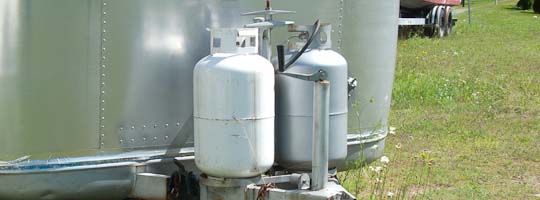Refueling Propane Cylinders and Tanks

IT'S THE LAW
Before entering a gasoline or propane refueling area, turn off all open flames, pilot lights, water heaters, furnaces, generators, and any appliances with automatic ignition devices. Turn the engine off.
It is essential to not only turn off all operating propane appliances but to switch off all appliances that might turn on automatically and generate a spark in the igniter.
Before permanently mounted propane tanks are refueled, all passengers should leave the vehicle as well.
Only qualified persons should fill your propane cylinders and tanks.
CAUTION: OVERFILLING IS HAZARDOUS! Do not allow your propane container to be overfilled.
Never allow your propane cylinder or tank to be filled above the maximum safe level as indicated by a OPD, a scale or the fixed liquid level gauge. Do not use the visible gauge for filling.
Stop filling when liquid appears at the fixed level gauge. Bleed off excess propane in a safe area. Most propane containers are equipped with a fixed liquid level gauge which contacts the liquid level at 80% of container capacity, allowing 20% for expansion. Cylinders not equipped with a fixed liquid level gauge can only be filled by weight.
Propane containers must not be filled over 80% of total capacity. Propane expands approximately 1.5% for each 10º F temperature rise. Pumps do not stop filling "automatically." Pumps "by-pass" when containers are dangerously filled to total capacity. If overfilled, excessive pressure could develop within the container causing the relief valve to open, relieving excess pressure. Gas released through the relief valve is flammable.
The fixed liquid level gauge is used only to determine safe fill levels and does not indicate lower levels. Propane containers are available with visible gauges that monitor the amount of gas in the container at all times, reading from full to empty. Do not use visible gauges for filling.
New cylinders or used cylinders that have been exposed to the atmosphere must be purged of air before being filled.
Air in propane containers is a contaminant. Purging is done prior to initial filling to remove the air. If the container is not properly purged, air in the container dilutes the gas vapor. Failure to purge may cause excessive tank pressure, slow filling and poor appliance operation. Appliances then require constant adjustment and pilot lights won't stay lit. This condition would exist until all air is depleted, leaving pure propane gas vapor.
Have your propane container properly purged. It only takes a few minutes and your propane dealer is equipped to perform this service (see NPGA bulletin 133-89A).
Tags: Propane